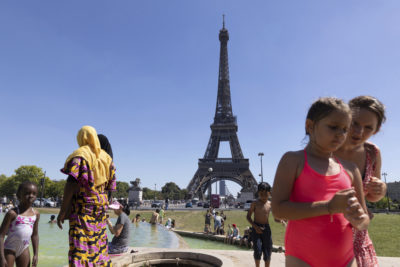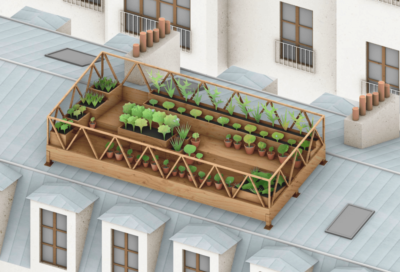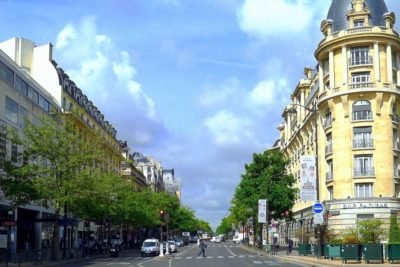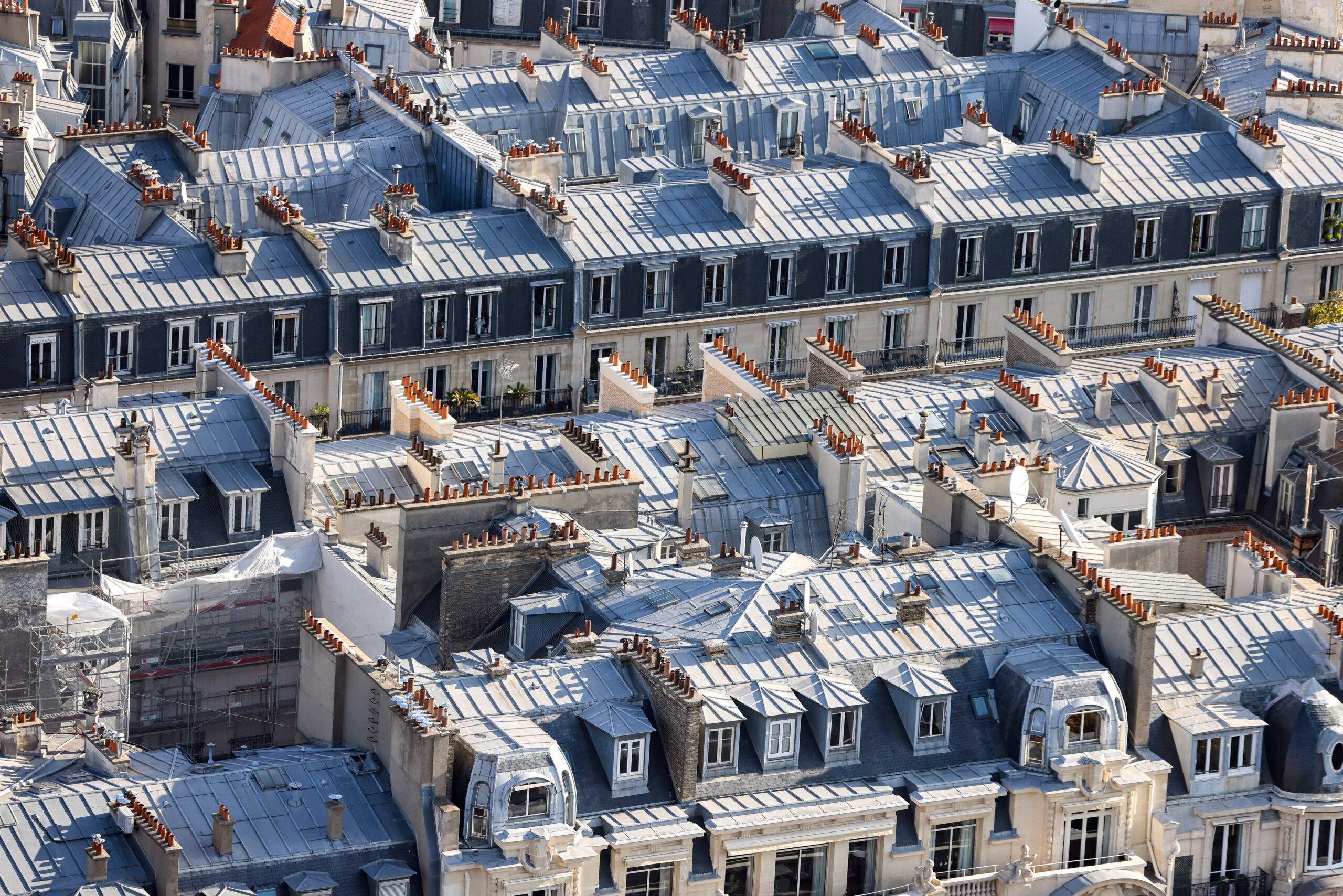There’s an extended custom in France of taking August off for vacation. Paris just about shuts down because the temperature drifts round within the seventies, and folks go to the seashore or the mountains to chill off and loosen up. Consider it as an previous‑customary adaptation to warmth. Individuals who stick round throughout August are sometimes older or have jobs that require them to remain and preserve town functioning.
In the summertime of 2003, Parisians who remained within the metropolis have been hit with one thing they weren’t accustomed to: a warmth wave. For 9 days in August, the daytime temperature was above 95 levels Fahrenheit (35 levels Celsius), generally spiking as much as 104 levels F (40 levels C). It didn’t cool off a lot at night time both. It took just a few days for the total scope of the tragedy to disclose itself. Hospital emergency rooms began to replenish. Every week or so into the warmth wave, metropolis officers started working out of locations to retailer our bodies.
In lower than two weeks, 15,000 individuals in France died as a direct results of the warmth wave. Almost a thousand lived in central Paris. Lots of the victims lived alone, in high‑ground garrets or attic flats, the place the warmth constructed up beneath zinc roofs and actually cooked individuals as in the event that they have been in an oven.
Making a metropolis that’s livable throughout excessive warmth is the good city engineering mission of our time.
Like each different metropolis on the earth, Paris was constructed by individuals who believed that the Earth’s local weather was steady. Sure, there have been cold and hot days, ebbs and flows of rivers, storms, and droughts, however the primary concept that there was a sure regular state and that the world would all the time return to it was by no means questioned. Simply as nobody constructed a metropolis on the coast with the belief that the polar ice sheets may soften and lift the water 5 – 6 toes in just a few many years, nobody constructed a metropolis with the belief that the temperature would leap 5 or 10 levels Fahrenheit or that excessive warmth waves would zap us. We constructed and lived within the Goldilocks Zone, and our cities are
part of that. They’re Goldilocks cities.
However now, like all the pieces else, these cities have to alter. That’s being introduced residence this month, as Earth has seen its hottest days on document, and lethal warmth waves have hit the U.S. Southwest, Southern Europe, China, India, and elsewhere. Making a metropolis that was not designed for excessive warmth right into a metropolis that’s livable throughout excessive warmth is the good city engineering mission of our time. Or, if that’s an excessive amount of, at the least making it a metropolis that’s not a dying lure for its residents.
For cities, the problem of thriving on a superheated planet is twofold. First, as cities develop, how do you make sure that they develop in a warmth‑sensible approach? One other 50 years of suburban sprawl just isn’t the reply. Cities have to be denser. Vehicles have to be changed with bikes and public transit. New buildings have to be not solely environment friendly and constructed of sustainable supplies, but in addition protected for individuals throughout more and more intense warmth waves. Which means extra inexperienced area, extra bushes, extra water, extra shade, extra thermally clever city design.

Parisians cool off on the Trocadero Fountain throughout a warmth wave, August 3, 2022.
Raphael Lafargue / Abaca / Sipa by way of AP Photos
The second, and harder, problem is determining what to do with present buildings and cityscapes. The overwhelming majority of present buildings are ailing‑suited to the acute local weather of the twenty first century: poorly insulated, poorly sited, depending on air-conditioning to maintain them liveable. Do you tear them down and rebuild? Do you retrofit? How do you create extra inexperienced area in already crowded internal cities?
In lots of cities, this city reworking mission is already underway. In New York Metropolis, staff and volunteers have planted over 1,000,000 bushes so as to add shade and clear the air. In Seville, Spain, metropolis planners are utilizing the expertise of historic underground waterways to offer cooling for town with out relying on air‑conditioning. In Freetown, Sierra Leone, officers are creating city gardens, bettering entry to scrub water, and erecting plexiglass awnings over outside markets. In Los Angeles, public works crews are portray streets white to extend reflectivity. In India, they’re experimenting with inexperienced roofs, which take up warmth and create area to develop meals.
However maybe nowhere on the earth do the challenges, in addition to the alternatives, loom bigger than in Paris, the place almost 80 p.c of the buildings have zinc roofs — an inexpensive, corrosion-resistant and just about inflammable innovation of the 19th century. However these roofs are, within the 21st century, lethal — heating as much as 194 levels F (90 levels C) on a summer time day. And since high‑ground garrets weren’t insulated, that warmth is transferred immediately into the rooms beneath.
Paris just lately handed a legislation requiring inexperienced roofs on new business buildings above a sure dimension.
What’s to be accomplished? Including insulation beneath the zinc can be very costly. Portray the roofs white may assist. Gentle colours enhance the albedo, or reflectivity, of buildings, deflecting daylight and inflicting much less warmth to be absorbed. White roofs could be remarkably efficient in sunny climates. Researchers at Australia’s College of New South Wales decided that white roofs decreased indoor temperatures by as much as 7 levels F (4 levels C). However because the zinc roofs in Paris are already mild‑coloured, the influence can be extra modest.
Inexperienced roofs are one other chance. In 2020, three younger Parisians based an organization known as Roofscapes to construct what quantities to wood platforms that relaxation on load-bearing partitions and sit atop the zinc roofs, which may turn out to be rooftop terraces. “Individuals can develop meals and get safety from the warmth on the similar time,” stated Olivier Faber, one of many cofounders of the corporate. Paris officers haven’t any downside with inexperienced roofs on new buildings — in reality, town just lately handed a legislation requiring them (or photo voltaic panels) on all new business buildings above a sure dimension. It’s the previous buildings which are the issue.
The cooling of Paris started in 2014, with the election of Anne Hidalgo as mayor. After closing a number of roadways and constructing bike lanes — not with out controversy — she pivoted from automobiles to bushes. Regardless of Paris’ many parks, town has one of many lowest tree cover covers of any metropolis on the earth — solely 9 p.c, in contrast with 27 p.c in Boston and 29 p.c in Oslo. In the summertime of 2019, Hidalgo launched an city forest marketing campaign, vowing to “considerably inexperienced” schoolyards across the metropolis in addition to 4 emblematic websites: the Hôtel de Ville, the Gare de Lyon, the sq. behind the Opéra, and a lane on the banks of the Seine.

A rendering of a rooftop terrace put in by the Parisian startup Roofscapes.
Roofscapes
Bushes are superheroes of the local weather battle. They inhale CO2 and exhale oxygen, filtering out air air pollution with every breath. They suck up water from the bottom and sweat it out by way of their leaves, which cools the air. And naturally they supply shade to all creatures nice and small, in addition to to the soil round them, which helps to scale back water loss by way of evaporation.
As a part of Hidalgo’s city forest initiative, town plans to plant 170,000 new bushes by 2026. That will sound like lots, however let’s put it into perspective. New York Metropolis has planted over 1,000,000 bushes and remains to be going. Milan’s city forest mission is planting 300,000 bushes a yr, with a purpose of three million new bushes within the metropolis by 2030. Simply to provide you a way of what this implies on a world scale, there are about 3 trillion bushes on the planet — which works out to about 422 bushes for each particular person on Earth. People are answerable for the lack of 15 billion bushes a yr. About 5 billion new bushes are planted or sprout yearly, yielding a web loss annually of 10 billion bushes. In order a lot as individuals could love bushes, within the huge image, we’re not superb to them. For the reason that starting of human civilization, the variety of bushes on the planet has dropped by 46 p.c.
Nonetheless, 170,000 bushes are 170,000 bushes. And in relation to cooling off a metropolis, bushes matter. In the course of the summer time of 2022, one researcher discovered that on a sizzling afternoon the temperature on the bottom in entrance of the Paris Opera Home measured 133 levels F (56 levels C). A couple of steps away, beneath the shade of the bushes on Boulevard des Italiens, the temperature on the sidewalk was solely 82 levels F (28 levels C).
“We are able to save the long run or we will save the previous, however we will’t do each,” says one Parisian architect.
However in a quickly altering local weather, bushes will not be a easy reply to city warmth. For one factor, it’s a lot simpler to plant a tree than to maintain it alive. In Los Angeles, metropolis officers estimate that it prices $4,351.12 to plant and keep a single oak tree for 5 years. Then there’s the query of who’s answerable for sustaining them. Based on one tree advocate in Phoenix, the typical life expectancy for a road tree in that metropolis is just seven years.
Even when they’re correctly cared for, metropolis bushes have a troublesome life. Canine pee on them. Their roots are coated by asphalt and concrete. Lovers carve their initials into their
bark. Drunk drivers run into them. In Athens, an invasive beetle is decimating the mulberry bushes that present shade in public squares. Ash bushes, which make up nearly all of shade bushes in U.S. cities like Chicago and Milwaukee, have been worn out by the emerald ash borer, an Asian jewel beetle that arrived in North America within the early 2000s.
Deciding which bushes to plant just isn’t a easy matter both. To guard towards widespread losses from illness and invasive species, range is vital. However the local weather of cities as we speak won’t be the local weather of cities in 2050. Arborists and concrete planners discover themselves casting ahead, which bushes is likely to be finest suited to future circumstances. In central Paris, the ever present London aircraft bushes are goners, susceptible in a warming local weather, and are being changed by evergreens, oak, and buckeye. In Tucson, palm bushes are out, and paloverde and mesquite are in.

The tree-lined Boulevard des Italiens is far cooler than close by streets that lack bushes.
Mbzt by way of Wikipedia
The centerpiece of the remaking of Paris is the Champs‑Élysées, the once-grand boulevard that runs between the Arc de Triomphe and the Place de la Concorde. In line with Hidalgo’s imaginative and prescient of a cooler, greener metropolis, architects with the French agency PCA-Stream have developed a plan to remove a number of lanes of site visitors to make room for bike lanes and broader pedestrian paths. The black asphalt can be eliminated and changed with a lighter‑colour paving that will replicate away daylight. Rainwater can be captured and recycled. And greater than a thousand bushes can be planted in open soil that permits tree roots to mingle. Apart from making the Champs‑Élysées safer, greener, and extra enjoyable to go to, the architects estimate the makeover would decrease the world’s sidewalk temperature by greater than 7 levels F (4 levels C).
After all, all this retrofitting, and different giant public works, will take an unlimited quantity of money and time, to say nothing of steady political management and consensus amongst stakeholders, a lot of whom would favor to see no change in any respect. As Phillipe Chiambaretta, the co-founder of PCA-Stream, informed me, “What’s going to get constructed, how far we can go along with this, I don’t know but. We are able to save the long run, or we will save the previous, however we will’t do each.”
“Right here in Paris, there are three choices,” says a metropolis council member. “We roast, we flee, or we act.”
Franck Lirzin, who labored as an advisor to the French authorities through the 2003 warmth wave and wrote an influential ebook about how Paris can adapt to local weather change, fears that guidelines and legal guidelines will make it impossibly tough to switch historic buildings within the middle of town. “As a result of the warmth just isn’t going to cease quickly, individuals must do one thing,” Lirzin says. “And what they may most likely do is identical factor that individuals are doing everywhere in the world — purchase an air conditioner and stick it within the window. And for Paris, that will be a catastrophe. It could enhance the demand on the gird, which might enhance the danger of blackouts. And it could be ugly.”
There are different methods to chill off Paris. Lirzin factors out that many public buildings already use a district cooling system, which circulates water chilled by being underground by way of pipes within the constructing. The system might be expanded to incorporate different components of Paris, in addition to non-public houses.
Buildings may be retrofitted in order that they don’t want synthetic cooling in any respect. One French structure agency took 530 flats in an unpleasant, inefficient concrete authorities housing constructing in Bordeaux and reworked them into vivid, ethereal, nicely‑ventilated dwellings. They usually did it cheaply, and with out displacing any residents. Why not scale the concept up and retrofit each previous constructing in Paris?

The Grand Parc housing property in Bordeaux, France in 2014 (left) and 2015 (proper), after it was transformed to permit in additional mild and supply higher ventiliation.
Philippe Ruault
Alexandre Florentin, a Paris metropolis council member, is a part of a rising variety of younger Parisians who see excessive warmth as a mortal menace to the Metropolis of Gentle. It’s not simply the zinc roofs, he stated. It’s the truth that faculties aren’t insulated or air‑conditioned, hospitals are poorly constructed for warmth, and the overwhelming majority of Parisians in his district are uneducated about deal with warmth. Florentin fears town is headed for an apocalyptic future: summer time blackouts, overrun emergency rooms, meals shortages, epic site visitors jams as individuals escape town, firefighters dying of heatstroke as they battle wildfires within the Bois de Vincennes, Paris’s largest public park. “Now we have entered a brand new local weather and vitality paradigm,” Florentin argued. “We’d like a social and cultural transformation on a degree that I’m afraid individuals who have been in energy for the final 20 years can’t actually think about.”
The established order just isn’t an possibility. A technique or one other, Paris — like each different metropolis in
the mid‑latitudes — goes to be reshaped by excessive warmth simply as certainly because it has been reshaped over the centuries by conflict and illness and commerce. Florentin pushed town council to ascertain a 15‑member fee known as “Paris at 50°C,” which is able to maintain public conferences across the metropolis and make suggestions to the total council about the very best methods to adapt to excessive warmth. “Right here in Paris, there are three choices,” Florentin stated bluntly. “We roast, we flee, or we act.”
Tailored from The Warmth Will Kill You First: Life and Loss of life on a Scorched Planet by Jeff Goodell, with permission of Little, Brown and Firm. Copyright © 2023 by Jeff Goodell.
